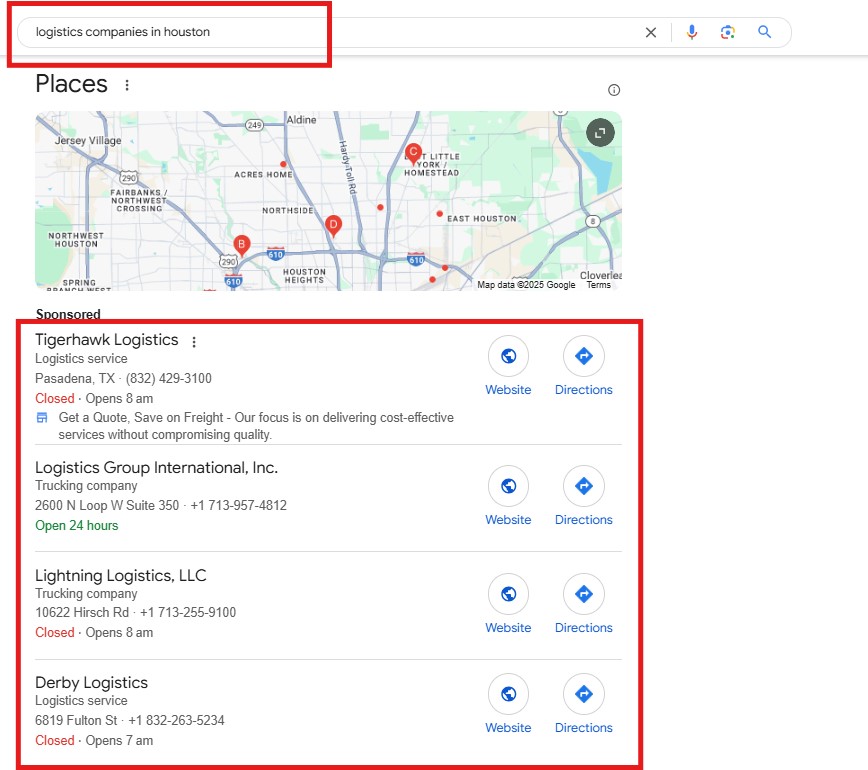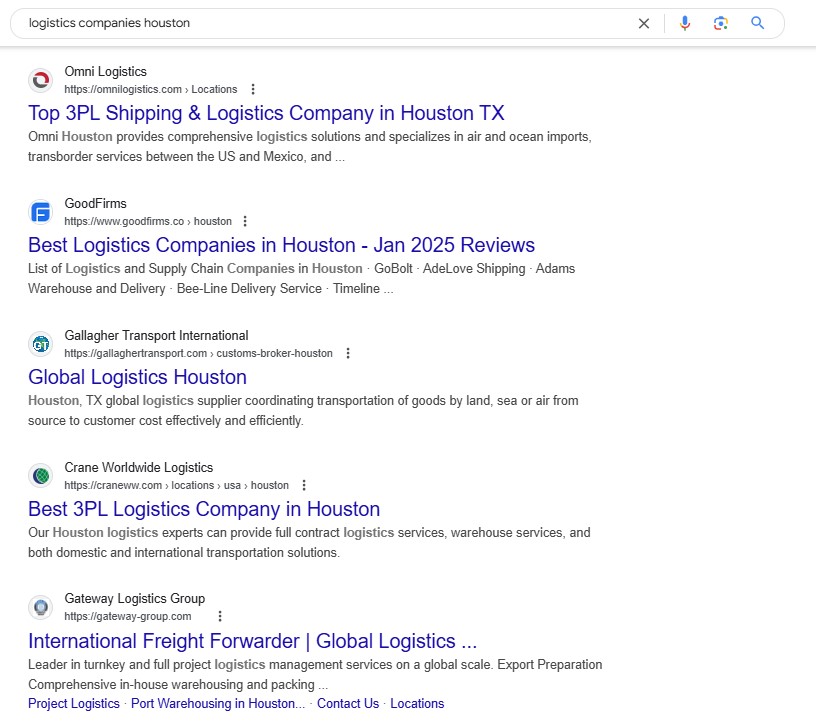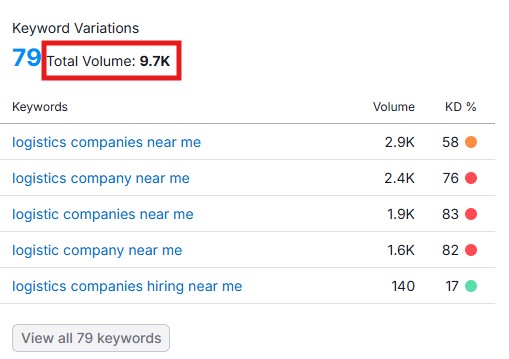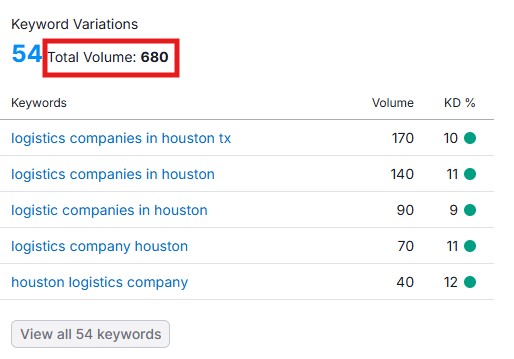Digital Marketing for Logistics: Driving Growth Using a Multi-Channel Approach

If you’re the head of a logistics company, picture this:
- You have hundreds of local visitors to your website each month.
- You convert leads from your website.
- Your email and voicemail inboxes are full of requests for work orders.
- Your calendar is fully booked each month.
- You have 100% clarity on how well your digital marketing performance is going.

This seems too good to be true, right?
Here’s the good news: we’re here to explain how you can turn your dreams into reality with the perfect digital marketing campaign for your logistics company.
We’re a Marketing Agency Specializing in Logistics
The Houston Marketing Agency knows what works and what doesn’t work.
We have years of experience in the industry and can create the ideal digital marketing campaign for logisticians.
Contact us today for a free initial consultation. No strings attached.

The Holistic Playbook for a High-Performing Logistics Company Digital Marketing Campaign
Our clear processes and proven strategies make us a top-performing Houston Marketing Agency that consistently gets results for our clients.
Your digital marketing journey will focus on three critical components:
- Set up data analytics so you can track your campaign’s performance.
- Drive inbound traffic to your website.
- Convert that traffic into customers.
Seems easy enough, right?
While this seems straightforward, the results won’t benefit you if they aren’t trackable.
How would you answer the following questions about your logistics company’s digital marketing campaign?
- How many organic visitors did your website get from Google last month?
- What is your cost per qualified lead from Google Ads?
- What is your website’s conversion rate?

If those questions left you confused, that’s okay!
Our team is here to guide you through each step of the process so you can understand how it all works. We are a digital marketing agency, but we are also a “data agency.” What this means for you is that we can help you understand what works and what doesn’t work, allowing us to build a personalized, holistic, high-performing campaign.
Phase 1: Build Robust Data Analytics
Trackable KPIs
Data tracking is the foundation of logistics digital marketing best practices. If you don’t have a way to reliably track your data analytics and are making decisions based on gut feelings alone, you are not going to see results.
Some essential KPIs that you should be tracking for your logistics company include:
- On-time delivery rate
- Cost per shipment
- Inventory turnover ratio
- Distribution transit time
- Warehousing cost
- Vehicle fleet utilization rate
- Supplier compliance
These factors are unique to logistics management companies and important to the success of your business but aren’t directly related to digital marketing.
There are other KPIs that are centered around digital marketing you should be tracking such as:
- Number of website visitors by channel
- Costs pers by channel:
- Cost per website visitor
- Cost per lead
- Cost per qualified lead
- Cost per conversion
Data Fidelity
Data fidelity isn’t an area that other marketing agencies prioritize. We’ve inherited campaigns from other agencies and freelancers and discovered issues such as:
- Double counting conversions
- Tracking irrelevant conversions (such as someone looking up directions to your facility on Google)
- Not tracking each step of the funnel to clearly understand drop-off and conversion rates
The Houston Marketing Agency strives to provide perfect data tracking that is relevant to your digital marketing campaign.
Phase 2: Maximize Affordable Inbound Traffic
Digital marketing is important for logistics management companies. That’s a given. However, to make the most out of your campaign, we need to understand why people search for logisticians and logistics companies.
Knowing why people search for your industry can help you focus your digital marketing campaign on specific targets and strategies to maximize your traffic at the lowest cost.
The fact of the matter is, nowadays, Google has become the top search engine for people who need to look something up. “Google it” has become synonymous with “I need to find the answer to a question.”
So, looking at Google statistics is an ideal starting place for gathering digital marketing data.
Looking at this data you can see that 9,700 users per month searched for logistics companies near them.
When looking for a logistics company, users often use city-specific keywords. So, in this example, you see that there are 680 potential customers a month in Houston alone searching for logistics companies.
Why does this matter?
If you aren’t performing well in both organic and paid traffic, you are missing out on potential customers for your business.
Organic
There are two places you can organically rank on Google for keywords like “logistics companies near me.”
First up is the Google Local Pack.

Ok, so how do I get my logistics company to rank in the Google Local Pack?
Long story short: local SEO is complex, with a lot of moving parts behind the scenes, but the basic formula is:
- Have an optimized and highly-reviewed Google Business Profile.
- Have plenty of localized content on your website.
Next, under the Google Local Pack on the results page, you’ll see the organic results.

Excellent! So, how do I get my business to rank in the top organic results?
Not to sound like a broken record, but the inner workings of SEO are complex. You can start by:
- Creating a website that is content-rich and comprehensive.
- Optimizing your on-page SEO, such as title tags, meta descriptions, etc.
Paid
Not all paid channels are going to perform the same. How well a paid channel performs is dependent on your company, prospective clients, location, and other various factors.
When thinking of your digital marketing campaign budget, here are some of the places you may consider investing your resources in.
Google Ads
Google Ads are paid options that help you rank at the top of the results page. Google Ads are marked by the word “sponsored” next to the result.
When used correctly, your target audience will see your website, click your link, and potentially become a customer.
It’s worth noting that not all Google Ads are the same. We can test different types of Google Ads to see which performs the best. Some of the different types of ads include:
- Search
- Display
- Performance Max
- And more
YouTube Ads
YouTube Ads are a great way to visually connect with potential customers in targeted ads highlighting your company’s services and values, such as:
- Reliability
- Security
- Technology and tracking
- Customer support
- And more
Facebook, Instagram, and TikTok Ads
Before diving into social media ad campaigns, it’s important to understand that each platform targets different age demographics.
These aren’t hard and fast rules, and there’s some crossover between age groups across the different platforms, but for the most part, you can assume that:
- Facebook is preferred by GenX.
- Instagram is preferred by GenX and Millenials.
- TikTok is preferred by Millenials and GenZ.
You can use this information to your advantage by knowing your target audience.
For example, as a logistics company, you can likely assume that GenZ users aren’t going to be the ones searching for supply chain management or shipping & freight services. As such, spending time and money on a TikTok ad campaign may not be worth your while.
Conversely, if you know that the majority of your customers are GenX-ers, investing resources into a Facebook ad campaign may be a better bang for your buck.
Phase 3: Increase Conversion Rates
So far, we’ve gone over how to get users to your website. Which is great! Getting users to your website is the first step, but we’ve still got work to do.
Now we need to get these users to convert to customers.
Ok, but how? There are things you can do to make this happen.
Use CRO Best Practices
CRO refers to conversion rate optimization and includes factors such as:
- Having a website that is easy to navigate and mobile-friendly
- Making sure your videos and images are high-quality and unique
- Adding reviews and testimonials from satisfied customers
Since there are countless strategies out there to increase conversion rates, we can’t go into the specifics of every single one. However, these are some we typically recommend that yield positive results.
Split Test Landing Pages
The fastest way to determine if website copy, design, and/or other on-page elements are increasing conversion rates is to run split tests.
Here’s how split tests work:
- Landing Page A is the control page.
- Landing Page B is the test page where you take Landing Page A and change one component on it.
- Example: Change the buttons on the page from “Contact Us” to “Schedule a Consultation.”
Comparing your control page to your test page allows you to see which components draw in more users. Consistently running split tests and making necessary changes can increase conversions.
Clear CTAs
When someone visits your company’s website, they should see clear and actionable Calls to Action (CTAs) throughout your entire page.
For your logistics company, these may look like:
- Schedule a consultation
- Fill out a contact form
- Request a pickup
- And more
Regardless of your process, your CTAs need to be clear and simple.
Optimizing the Funnel
A user won’t automatically go from being an interested Google searcher to a customer ready to book a shipment. There will inevitably be drop-offs along the way as they decide not to continue on the path to conversion.
You can find clarity on where these drop-offs are happening and use your campaign to minimize them by following these recommendations:
- Find clarity on where the drop-off points are.
- Optimize drop-off points through data-driven tests.
- Monitor performance.
- Continue testing.
Increase LTV on Autopilot
So now that you’ve increased traffic and converted those users into customers, mission accomplished, right?
Not quite.
You’ve done the hard work to gain customers, but now you need to increase the lifetime value (LTV) of each customer. You want them to come back as repeat customers and push out referrals for you.
Email Automation for Repeat Services and Referrals
After you complete a project or job for a customer, you don’t want that to be the end of their story with you. Odds are, they will need to ship, store, and transport goods for their business again. You want your logistics company to be the first one they think of when the time comes.
Stay at the front of your customer’s minds through automated emails. Continuously reaching out to customers and sharing promotions, completed projects, and any upgrades can remind them of your services.
In the meantime, if a customer doesn’t need services, they can still benefit you through word-of-mouth referrals. Providing reminders and referral incentives can increase the likelihood of them passing on your information to their peers who are potential customers.

Digital Marketing for Logistics Doesn’t Have to Be Hard
The Houston Marketing Agency is here to help local and national logistics companies reach their goals through successful digital marketing campaigns.
We can help you increase your inbound traffic and conversions with digital marketing strategies tailored specifically for your company. We are so confident in our work that we offer a 100% refund if we can’t improve your performance within three months.
Contact us today to get started.


